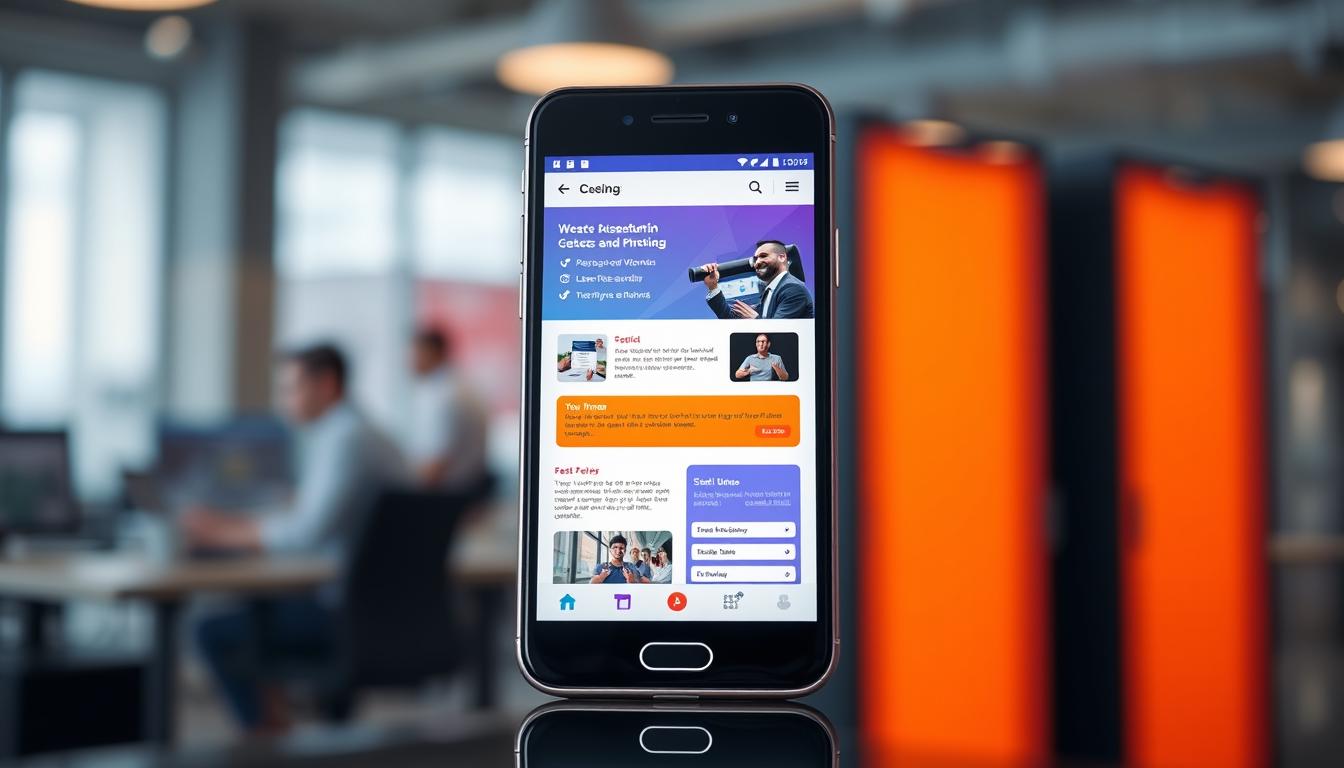It is noteworthy that more than 54% of global web traffic originates from mobile devices. This trend underscores the imperative of optimizing your site with mobile-friendly website design. A responsive website design not only elevates user experience but also profoundly influences your business’s online success. Key components such as streamlined navigation, optimized images, and rapid load times are indispensable for crafting a seamless mobile experience. Furthermore, tools like Google’s Mobile-Friendly Test facilitate the evaluation of your website’s mobile optimization, ensuring your competitive edge in this dynamic landscape.
Key Takeaways
- Mobile traffic constitutes over half of all web visits globally.
- Responsive website design adapts easily to different screen sizes.
- Optimized images can boost load times on mobile devices.
- Simplified navigation helps improve user engagement.
- Testing tools are available to assess mobile-friendliness effectively.
Understanding Mobile-Friendly Website Design
The imperative of crafting a mobile-friendly website design is paramount in today’s digital landscape. This methodology prioritizes delivering an unparalleled user experience, specifically optimized for mobile devices. Given the prevalence of smartphones and tablets in internet usage, enterprises must recalibrate their online presence to effectively engage users.
What It Means to Be Mobile-Friendly
A mobile-friendly website is distinguished by its adaptability and simplicity on smaller screens. Its defining characteristics include:
- Responsive layouts that adapt effortlessly to diverse screen sizes.
- Scalable images that preserve quality without compromising load times.
- User-friendly web design principles ensuring seamless navigation and interaction.
Adopting a mobile-first design strategy not only streamlines the development process but also places the needs of mobile users at the forefront.
Why It’s Critical for Your Business
In today’s market, mobile users constitute a substantial segment of web traffic. The absence of a mobile-friendly website can result in a suboptimal user experience, deterring potential customers. Businesses risk forfeiting crucial interactions and conversions. For further insights on enhancing your site’s mobile experience, refer to this resource on mobile website design.
The transition towards mobile-friendly website design transcends a mere trend; it is a critical imperative that influences sales, brand loyalty, and overall success.
The Importance of Responsive Design
Responsive website design is a cornerstone in contemporary web development, enabling websites to dynamically adjust to diverse screen sizes and orientations. This adaptability is paramount in the current digital era, where a substantial portion of web traffic emanates from mobile devices. Such flexibility is indispensable for delivering an optimal mobile user experience.
Benefits of a Responsive Layout
Employing a responsive layout confers manifold advantages:
- Improved user retention: Visitors are more inclined to remain on a site that offers a seamless browsing experience.
- Decreased bounce rates: Immediate access to information without interruptions fosters user engagement.
- Enhanced SEO rankings: Search engines prefer sites that prioritize mobile optimization, thereby increasing organic traffic.
Comparing Responsive vs. Adaptive Design
Responsive and adaptive designs both aim to elevate the user experience, albeit through distinct methodologies:
- Responsive design: Automatically adjusts layouts based on screen size, ensuring a fluid experience across devices.
- Adaptive design: Deploys fixed layouts specifically designed for particular devices, potentially offering less flexibility.
Selecting the appropriate design strategy is imperative for guaranteeing an exemplary mobile user experience. Grasping the nuances between these approaches is essential for businesses to make strategic decisions regarding their online presence. For further insights, refer to the terms of use.
Key Elements of Mobile-Friendly Websites
A successful mobile-friendly website design encompasses several critical elements, enhancing user experience and ensuring accessibility for all. By concentrating on these aspects, businesses can establish a platform that caters to the demands of contemporary users.
Simplified Navigation
Simplified navigation enables users to access information swiftly and efficiently. A clear menu structure, intuitive buttons, and logical page layouts contribute to a user-friendly experience. By minimizing clutter, visitors experience greater ease, thereby reducing the frustration often associated with complex navigation. This streamlined approach is indispensable for mobile environments.
Optimized Images and Media
High-quality images and media are vital for engaging visitors, yet they can impede website performance if not optimized. Utilizing compressed file formats ensures images retain their clarity without compromising loading speed. This optimization is crucial for achieving a fast loading website, essential for retaining users and enhancing overall engagement.
Faster Load Times
The significance of rapid loading times cannot be overstated. Websites that load quickly significantly reduce bounce rates, leading to improved retention and conversion rates. Furthermore, adhering to website accessibility standards ensures that all users, including those with disabilities, can navigate efficiently. Prioritizing speed and accessibility significantly enhances the effectiveness of a mobile-friendly website design.
User Experience Best Practices

The creation of a seamless mobile user experience necessitates a design that is both meticulous and intuitive. With the proliferation of touchscreens, it is imperative that your website is not only functional but also engaging. To enhance your site’s accessibility and enjoyment on mobile devices, adhere to the following best practices.
Touchscreen Considerations
In the realm of mobile design, prioritize the implementation of larger buttons and interfaces that are touch-friendly. This approach significantly enhances usability, fostering an environment that is more inviting for users. The adoption of intuitive user-friendly web design will inevitably lead to increased engagement rates and heightened customer satisfaction. Consider integrating features such as:
- Generous spacing between interactive elements
- Simple gestures for navigation
- Consistent layouts across pages
These considerations facilitate better interaction and navigation, ensuring a delightful mobile user experience.
Avoiding Flash and Pop-Ups
In the context of mobile design, the avoidance of Flash is paramount, given its incompatibility with many devices. Flash content can often disrupt the user experience, leading to frustration. Furthermore, intrusive pop-ups can impede user navigation, thereby diminishing the effectiveness of your communication. For optimal performance, focus on developing your site with:
- HTML5 for animations and media
- Simple, non-intrusive notifications
- A streamlined pop-up strategy that enhances rather than disrupts
By prioritizing these aspects, you promote a more fluid experience for users. For further insights on effective design strategies, consider consulting this best practices resource.
SEO Benefits of Mobile-Friendliness
The creation of an SEO-friendly web design is paramount for augmenting online presence. Mobile-friendly websites are increasingly preferred by search engines, influencing overall traffic and user engagement. A site optimized for mobile offers a superior user experience, characterized by faster load times and enhanced navigation.
Improved Search Engine Rankings
Search engines, notably Google, prioritize mobile-friendly sites. The incorporation of responsive features ensures content accessibility across all devices. This optimization results in lower bounce rates and higher user retention. Consequently, businesses achieve enhanced search engine rankings, thereby increasing their audience reach.
Local SEO and Mobile Searches
The proliferation of mobile searches has underscored the significance of local SEO. Many consumers employ their smartphones to locate businesses in their vicinity. An SEO-friendly web design, optimized for mobile, becomes crucial for capturing local traffic. By effectively targeting local customers, businesses can boost their visibility and attract more foot traffic.
Tools for Testing Your Website’s Mobile-Friendliness

Assessing the mobile-friendliness of your website is paramount for guaranteeing a superior user experience. A plethora of testing tools are at your disposal to evaluate your site’s performance on mobile devices. These tools enable you to pinpoint areas needing enhancement and thus, elevate your Google mobile-friendly ranking.
Google Mobile-Friendly Test
The Google Mobile-Friendly Test stands as a pivotal resource for website proprietors. It scrutinizes whether your site adheres to mobile-friendly standards, offering a succinct analysis of your design. By merely inputting your website’s URL, you will promptly receive a report outlining text readability, tap target size, and overall responsiveness. This tool provides immediate insights into the impact of your site on your Google mobile-friendly ranking.
Other Useful Testing Tools
Beyond the Google Mobile-Friendly Test, a myriad of additional testing tools can augment your evaluation endeavors:
- BrowserStack: This platform facilitates real-time testing across diverse browser and device combinations, enabling you to gauge how your site appears on various platforms.
- GTmetrix: Specializing in performance, GTmetrix evaluates your site’s loading speed and offers recommendations for enhancement, essential for a successful mobile-friendly website design.
Employing these testing tools allows for the effective monitoring and refinement of your website’s mobile experience. For professional guidance and comprehensive analysis, consider contacting design specialists through these services. Evaluating your mobile site’s performance can lead to substantial improvements in user engagement and satisfaction.
Adapting Content for Mobile Users
The creation of content specifically designed for mobile users is paramount for achieving optimal mobile optimization. It necessitates a focus on user-friendly web design, ensuring navigation and comprehension are uncomplicated. The utilization of shorter text paragraphs is crucial for enhancing readability on smaller screens, facilitating effortless information absorption.
Shorter Text Paragraphs
To maintain user engagement, brevity is paramount. Content should be crafted with:
- Concise sentences that convey the message swiftly
- Information segmented into logical, manageable chunks
- Bullet points for lists to enhance clarity
This strategy not only facilitates comprehension but also elevates the mobile experience. A layout characterized by shorter paragraphs facilitates scanning, thereby maintaining user interest.
Clear Call-to-Actions
Strong call-to-action buttons are essential for guiding users through their mobile experience seamlessly. A clear call-to-action prompts users to undertake specific actions, such as subscribing to a newsletter or making a purchase. Consider the following tips when implementing call-to-actions:
- Employ actionable phrases like “Get Started” or “Learn More”
- Position buttons prominently for effortless access
- Employ contrasting colors to make them visually striking
Integrating these elements within a mobile-friendly layout supports increased interaction, leading to enhanced conversion rates.
Common Mistakes to Avoid
The creation of a mobile-friendly website necessitates meticulous attention to detail and a profound comprehension of user preferences. Many enterprises fail to address critical aspects, resulting in common errors that significantly impair user experience and engagement.
Ignoring Mobile Page Speed
One of the most critical mistakes is the neglect of mobile page speed. Pages that load slowly can infuriate users, leading to elevated bounce rates. It is imperative to optimize images and streamline code to expedite load times. Devoting time to mobile page speed testing can significantly elevate user satisfaction, thereby enhancing retention and conversion rates.
Cluttered Layouts and Design
Another prevalent oversight is the creation of cluttered layouts that overwhelm users. A visually disorganized design can perplex visitors and obstruct their navigation. Achieving a balance between aesthetics and usability is paramount. It is essential to strive for a clean, organized layout that facilitates effortless navigation through content. Excessive elements should be avoided to prevent distraction from the primary message, ensuring a gratifying browsing experience.
Staying Updated with Mobile Trends
In the rapidly evolving realm of mobile technology, staying updated with the latest trends is imperative for entities across the spectrum. Grasping emerging design paradigms is not merely beneficial; it is essential for elevating user engagement and bolstering mobile performance. As technological advancements unfold, maintaining synchrony with these developments is paramount to ensure websites remain both captivating and operational.
Emerging Trends in Mobile Design
Advancements such as minimalistic design and voice search optimization are swiftly gaining prominence. These innovations align with user desires for streamlined navigation and seamless interactions. By embracing these elements, enterprises can markedly elevate their mobile performance. Such adaptability not only mirrors consumer preferences but also fosters a deeper connection with the audience.
How Regular Updates Impact Mobile Performance
Consistent updates are indispensable for mitigating security risks and augmenting site functionality. They are pivotal in maintaining compatibility with the most recent devices and operating systems. A steadfast update regimen not only enhances mobile performance but also cultivates user trust. Organizations can refine their sites by delving into resources such as designing mobile-friendly websites. These strategies ensure the site’s continued relevance and user satisfaction.
The Cost of Not Going Mobile-Friendly
In the contemporary era, the reliance on smartphones and tablets for accessing websites has surged. Neglecting the imperative for mobile-friendly website design precipitates substantial challenges for enterprises. The resultant customer loss, as users eschew non-optimized mobile sites, underscores the criticality of mobile accessibility for all businesses.
Potential Loss of Customers
A site’s failure to offer a seamless mobile experience may prompt customers to opt for competitors. Studies reveal that a considerable proportion of users abandon a site within seconds if it fails to load efficiently or is cumbersome to navigate. Such customer loss not only hampers immediate sales but also jeopardizes long-term expansion.
Impact on Brand Reputation
Brand reputation is inextricably linked to the user experience. A site with a poor design can instill negative perceptions, undermining customer trust and loyalty over time. The endeavor to rectify a damaged reputation is resource-intensive and laborious. Emphasizing mobile-friendly website design represents a preemptive strategy to uphold a robust and affirmative brand image in the digital realm.
In an epoch where customers are endowed with myriad options at their disposal, the imperative to craft an effective mobile experience is paramount for retaining clientele and safeguarding brand integrity. For deeper insights into augmenting your digital footprint, consider exploring strategies for enhancement.
Partnering with Professional Design Services
Engaging with professional design services can revolutionize your web presence. These experts possess extensive knowledge and employ advanced techniques, enabling the creation of user-friendly web designs that captivate your audience. Collaborating with a web design agency offers the advantage of their expertise in developing mobile-friendly websites. These sites not only appear visually appealing but also function optimally across different devices.
Benefits of Hiring Experts
The benefits of hiring a web design agency extend beyond mere aesthetics. Their specialized skills in optimizing site performance can significantly improve loading times and enhance user engagement. Furthermore, professionals adeptly implement best practices in mobile design, ensuring your site’s search engine rankings are elevated. This makes it more accessible to potential customers, ultimately leading to a substantial return on investment through increased accessibility and user satisfaction.
Questions to Ask a Web Design Agency
Before engaging with a web design agency, it is imperative to pose specific questions that reveal their expertise. Inquire about their previous projects focused on mobile-friendly design and their strategies for creating engaging, user-friendly web design experiences. Understanding their approach not only evaluates their capabilities but also ensures their services align with your business objectives. For a deeper understanding of effective design practices, refer to this insightful guide on smart vacation planning.
